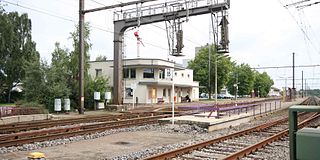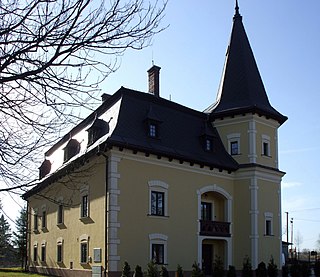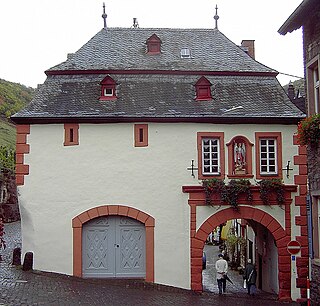
West Jefferson is a town in Jefferson County, Alabama, United States. It incorporated in October 1964. At the 2010 census the population was 338, down from 344 in 2000.
Sedulius Scotus or Scottus was an Irish monk, teacher, Latin grammarian, and scriptural commentator who lived in the 9th century. During the reign of the Emperor Lothair (840–855), he was one of a colony of Irish teachers at Liège. Sedulius is sometimes called Sedulius the Younger, to distinguish him from Coelius Sedulius. The usual Irish form of the name is Siadhal, but he appears to have been called Suadbar. It is quite probable that towards the end of his days he went to Milan, following the example of his countryman Dungal, who established a school at Pavia. When and where he died is unknown.

Chachersk is a town in Gomel Region, Belarus. It serves as the administrative center of Chachersk District. As of 2024, it has a population of 8,927.
The Europaviertel in Wiesbaden is a former barracks area named Gersdorff Kaserne at the edge of the city center of the Hessian state capital, approximately 2 kilometers southwest of the Marktkirche.

The Nobel Library is the public library of the Swedish Academy instituted to assist the evaluation of Nobel laureates to the Prize in Literature and other awards granted by the academy. The library is located in the so-called Stock Exchange Building at 4, Källargränd, a short alley passing between Slottsbacken and Stortorget in Gamla stan, the old town in central Stockholm, Sweden.

St. Mary Staining was a parish church in Oat Lane, northeast of St. Paul's Cathedral, in the City of London. First recorded in the 12th century, it was destroyed in the Great Fire of London in 1666 and not rebuilt.

Kleinbettingen railway station is a railway station serving Kleinbettingen, in the commune of Steinfort, in western Luxembourg. It is operated by Chemins de Fer Luxembourgeois, the state-owned railway company.
Valdetorres is a municipality located in the province of Badajoz, Extremadura, Spain. According to the 2005 census (INE), the municipality has a population of 1332 inhabitants.

Mansion is a building situated in Záturčie, Slovakia.

St. Matthias' Abbey is a Benedictine monastery in Trier, Rhineland-Palatinate, Germany.

The Graach Gate is the last remaining town gate of the German town of Bernkastel-Kues. The name Graach refers to the neighbouring village of Graach connected by a narrow road to the gate. Currently the building is used as a museum of local history.
Rundu State Hospital is a government hospital in Rundu, Namibia. Containing 300 beds, it was remodeled from 1991 to 1997.

Béjaïa District is a district of Béjaïa Province, Algeria.
Parada is a village in the municipality of Kuršumlija, Serbia. According to the 2002 census, the village has a population of 16 people.

St Michael's Chapel is the former Anglican chapel to Lancaster Moor Hospital, to the east of Lancaster, Lancashire, England. It was built in 1866 to a design by the local architect E. G. Paley. Its architectural style is Neo-Norman. The chapel is constructed in sandstone with ashlar dressings and a slate roof. Its plan is cruciform, consisting of a nave with a west porch, north and south transepts, and a chancel with an apsidal east end. The windows are round-headed with voussoirs of alternating red and yellow sandstone. Both transepts contain a rose window above two single-light windows. Since becoming redundant the chapel has been converted into flats. The former chapel is recorded in the National Heritage List for England as a designated Grade II listed building.
Ruđinci is a village in the municipality of Vrnjačka Banja, Serbia. According to the 2011 census, the village has a population of 2,466 people.

The Polish War Cemetery at Casamassima, was established in Casamassima, near Bari, in southern Italy, where there are about 431 graves of Polish soldiers and officers of the 2nd Polish Corps who died between 1944 and 1945. This small cemetery, mostly "Italian" in style, with decorative trees, is typical of the Mediterranean region and is located among surrounding vineyards.
Indian Slough is a slough, tributary to the Old River, an old channel of the San Joaquin River in California. Its mouth is at an elevation of 7 feet, at its confluence with the Old River. Its source is at its confluence with Kellogg Creek at an elevation of 7 feet at the location 37°54′58″N121°36′18″W.

The Proverbia Grecorum is an anonymous Latin collection of proverbs compiled in the seventh or eighth century AD in the British Isles, probably in Ireland. Despite the name, it has no known Greek source. It was perhaps designed as a secular complement to the Hebrew Bible's Book of Proverbs.

The Abstrusa Glossary is a glossary of Latin from the 7th or 8th century AD. Typical of such glossaries, it is named after its first lemma, abstrusa.













